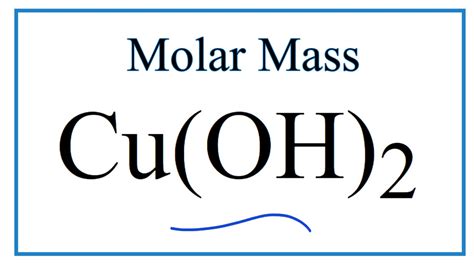Molar Mass Of Cu Oh 2
Juapaving
Apr 06, 2025 · 5 min read

Table of Contents
Understanding the Molar Mass of Cu(OH)₂: A Comprehensive Guide
Determining the molar mass of a compound is a fundamental concept in chemistry, crucial for various stoichiometric calculations and analyses. This article delves deep into understanding the molar mass of copper(II) hydroxide, Cu(OH)₂, explaining the process, its applications, and potential areas of confusion. We'll also touch upon related concepts and practical applications to provide a comprehensive understanding.
What is Molar Mass?
Molar mass, often used interchangeably with molecular weight, represents the mass of one mole of a substance. A mole is a fundamental unit in chemistry, defined as the amount of a substance containing Avogadro's number (approximately 6.022 x 10²³) of constituent particles (atoms, molecules, ions, etc.). The molar mass is expressed in grams per mole (g/mol). It's a crucial bridge connecting the macroscopic world (grams) to the microscopic world (atoms and molecules).
Calculating the Molar Mass of Cu(OH)₂
To calculate the molar mass of Cu(OH)₂, we need to consider the atomic masses of its constituent elements: copper (Cu), oxygen (O), and hydrogen (H). These atomic masses are typically found on the periodic table.
Step 1: Identify the Elements and Their Atomic Masses
- Copper (Cu): The atomic mass of copper is approximately 63.55 g/mol.
- Oxygen (O): The atomic mass of oxygen is approximately 16.00 g/mol.
- Hydrogen (H): The atomic mass of hydrogen is approximately 1.01 g/mol.
Step 2: Determine the Number of Atoms of Each Element
The chemical formula Cu(OH)₂ indicates:
- 1 copper atom (Cu)
- 2 oxygen atoms (O)
- 2 hydrogen atoms (H)
Step 3: Calculate the Total Molar Mass
To obtain the molar mass of Cu(OH)₂, we multiply the atomic mass of each element by the number of atoms of that element present in the formula and then sum the results:
Molar Mass of Cu(OH)₂ = (1 × Atomic Mass of Cu) + (2 × Atomic Mass of O) + (2 × Atomic Mass of H)
Molar Mass of Cu(OH)₂ = (1 × 63.55 g/mol) + (2 × 16.00 g/mol) + (2 × 1.01 g/mol)
Molar Mass of Cu(OH)₂ = 63.55 g/mol + 32.00 g/mol + 2.02 g/mol
Molar Mass of Cu(OH)₂ ≈ 97.57 g/mol
Significance and Applications of Molar Mass of Cu(OH)₂
Knowing the molar mass of Cu(OH)₂ is crucial for various chemical calculations and applications, including:
1. Stoichiometric Calculations:
Molar mass is fundamental for performing stoichiometric calculations, which involve relating the amounts of reactants and products in chemical reactions. For example, if you're trying to determine how much Cu(OH)₂ is needed to react completely with a specific amount of another reactant, you'll need its molar mass to convert between grams and moles.
2. Solution Preparation:
When preparing solutions of a specific concentration (e.g., molarity), the molar mass of Cu(OH)₂ is essential for accurately weighing out the required amount of the compound to achieve the desired concentration.
3. Gravimetric Analysis:
In gravimetric analysis, the mass of a precipitate is used to determine the amount of an analyte in a sample. If the precipitate is Cu(OH)₂, its molar mass is crucial for converting the mass of the precipitate to the moles of the analyte.
4. Understanding Chemical Reactions:
The molar mass helps in understanding the quantitative relationships between reactants and products in chemical reactions involving Cu(OH)₂. For instance, it allows us to predict the amount of a product formed based on the amount of Cu(OH)₂ used in a reaction.
Potential Sources of Confusion and Errors
Several factors can lead to errors in calculating or using the molar mass of Cu(OH)₂:
1. Incorrect Atomic Masses:
Using outdated or inaccurate atomic masses from the periodic table is a common source of error. Always use the most up-to-date values.
2. Misinterpreting Chemical Formulas:
Incorrectly interpreting the chemical formula Cu(OH)₂ can lead to mistakes in counting the number of atoms of each element.
3. Calculation Errors:
Simple mathematical errors during the calculation process can also affect the final result. Double-checking calculations is crucial.
4. Units:
Always pay attention to the units involved in the calculations. Ensure consistency and proper conversion of units to avoid errors.
Related Concepts and Further Exploration
Understanding the molar mass of Cu(OH)₂ opens doors to exploring related concepts:
- Percent Composition: Calculating the percentage by mass of each element in Cu(OH)₂.
- Empirical Formula: Determining the simplest whole-number ratio of atoms in a compound.
- Molecular Formula: Determining the actual number of atoms of each element in a molecule.
- Hydrates: Understanding the concept of hydrates and calculating the molar mass of hydrated Cu(OH)₂, if applicable.
- Solubility and Equilibrium: Exploring the solubility of Cu(OH)₂ and its equilibrium constant (Ksp).
Conclusion
The molar mass of Cu(OH)₂, approximately 97.57 g/mol, is a fundamental parameter used in numerous chemical calculations and applications. Understanding its calculation and significance is essential for any student or professional working in chemistry. By carefully following the steps outlined above and being mindful of potential sources of error, accurate and reliable results can be achieved. Further exploration of related concepts will enhance your understanding of this crucial chemical property. Remember to always double-check your work and utilize up-to-date atomic mass values from a reliable source. Mastering this concept lays a strong foundation for more advanced chemical calculations and analyses.
Latest Posts
Latest Posts
-
How Big Is 18cm In Inches
Apr 08, 2025
-
Two Compounds A And B Have The Formula
Apr 08, 2025
-
Which Cardiac Chamber Has The Thickest Wall
Apr 08, 2025
-
The Horizontal Rows Of The Periodic Table Are Known As
Apr 08, 2025
-
What Are The Two Main Functions Of Dna
Apr 08, 2025
Related Post
Thank you for visiting our website which covers about Molar Mass Of Cu Oh 2 . We hope the information provided has been useful to you. Feel free to contact us if you have any questions or need further assistance. See you next time and don't miss to bookmark.